Coronavirus (COVID-19): modelling the epidemic (issue no. 73)
Latest findings in modelling the COVID-19 epidemic in Scotland, both in terms of the spread of the disease through the population (epidemiological modelling) and of the demands it will place on the system, for example in terms of health care requirement.
This document is part of a collection
Coronavirus (COVID-19): modelling the epidemic in Scotland (Issue No. 73)
Background
This is a report on the Scottish Government modelling of the spread and level of Covid-19. This updates the previous publication on modelling of Covid-19 in Scotland published on 7th October 2021. The estimates in this document help the Scottish Government, the health service and the wider public sector plan and put into place what is needed to keep us safe and treat people who have the virus.
This edition of the research findings focuses on the epidemic as a whole, looking at estimates of R, growth rate and incidence as well as local measures of change in the epidemic.
In Scotland, the modelled estimate for R is between 0.8 and 1.0, with the growth rate between -3% and 0%.
Key Points
- The reproduction rate R in Scotland is currently estimated as being between 0.8 and 1.0, as of 28th September. The lower limit has increased since last week.
- The number of new daily infections for Scotland is estimated as being between 94 and 142, per 100,000 people. The lower and upper limits have decreased since last week.
- The growth rate for Scotland is currently estimated as between -3% and 0%.
- Average contacts have decreased by 7% in the last two weeks (comparing surveys pertaining to 16th September - 22nd September and 30th September - 6th October) with a current level of 4.6 daily contacts.
- Mean contacts within the home have increased by 9% whereas contacts in the other setting (contacts outside home, school or work) have decreased by 22% in the last two weeks. Contacts within the work setting have remained at a similar level over the same period.
- Those aged between 30-59 reported an increase in overall contacts whereas all remaining age groups reported a decrease, with those aged 18-29 reducing by half in the last two weeks. The decrease within the 18-29 is largely driven by a drop in contacts within the work setting.
- The proportion of individuals visiting a healthcare facility increased from approximately 17% to 23% with individuals visiting a pub or restaurant decreasing from 49% to 47% in the last two weeks.
- The proportion of contacts reported to have been indoors only has increased from 61% to 68% within the last two weeks.
- The number of people wearing a face covering where they have at least one contact outside of the home remains at a similar level to two weeks prior, currently at 81%.
- Hospital and ICU occupancies have plateaued, and are falling slowly. There continues to be uncertainty over hospital occupancy and intensive care in the next three weeks.
- Modelled rates of positive tests per 100K using data to 11th October indicate that, for the week commencing 24th October 2021, there are 29 local authorities which are expected to exceed 50 cases per 100k with at least 75% probability.
- There is one local authority (Dundee) which is expected to exceed 300 cases per 100k with at least 75% probability. There are no local authorities which are expected to exceed 500 cases per 100k with at least 75% probability.
- Nationwide, after a recent plateau, levels of Covid-19 in wastewater resumed falling this week, down around 40% from last week. Reductions in sampled levels at the major cities drove this decrease, though there remain high amounts of variability.
- Modelling of long Covid estimates that on 31st October 2021 between 1.1% and 2.4% of the population are projected to self-classify with long Covid for 12 weeks or more after their first suspected Covid infection in Scotland. The upper limit of the estimate is higher than last week.
Recent cases
Figure 1 shows the number of Covid-19 cases reported in Scotland between July and October 2021. The vertical dashed lines indicate the cut off points for each of the modelling inputs; after these dates, the number of cases is not incorporated into the outputs.
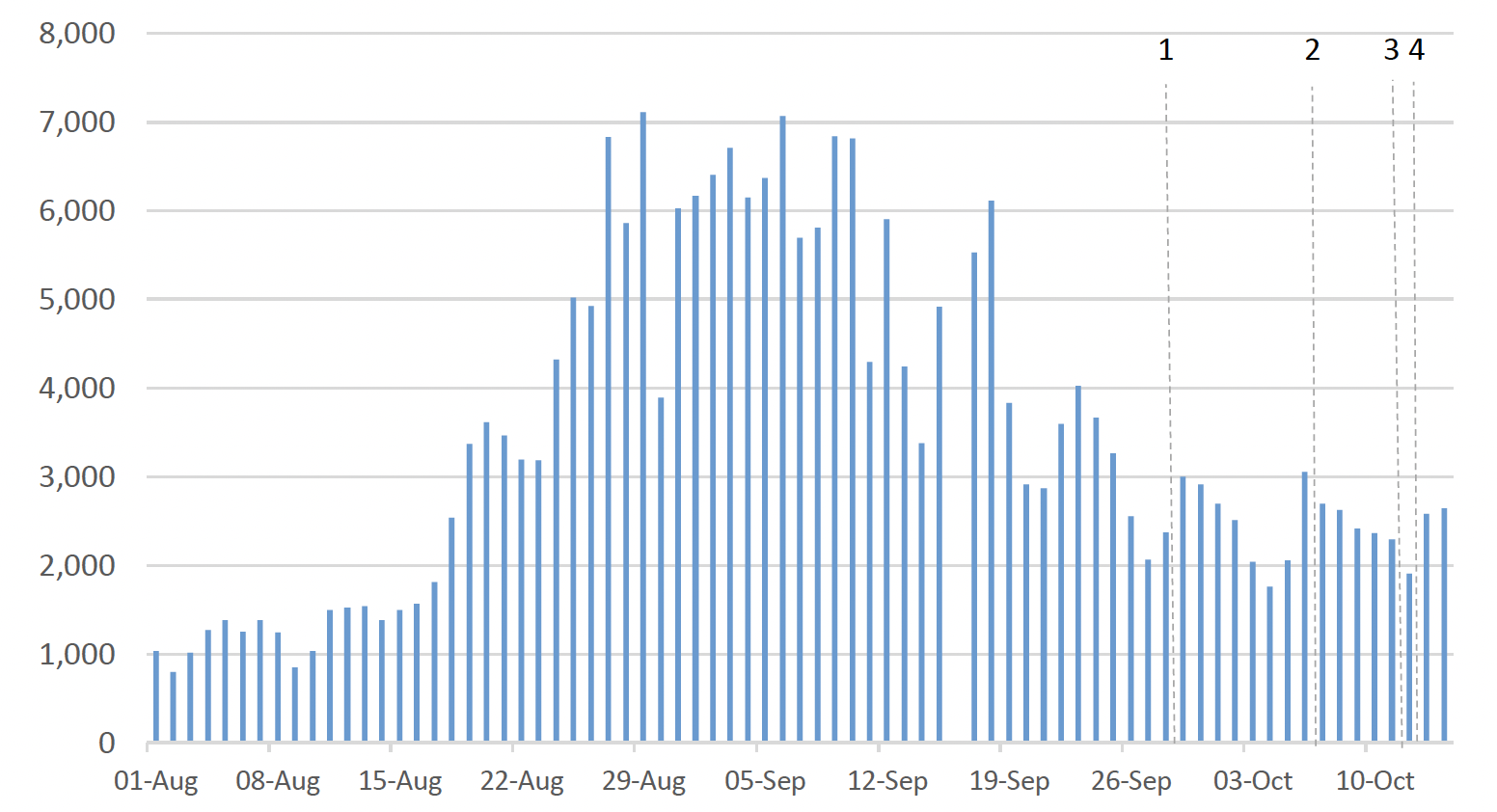
R, growth rate and incidence are as of 28th September (dashed line 1). The Scottish Contact Survey uses data to 6th October (dashed line 2). The medium term projections by the Scottish Government of infections, hospitalisations and ICU beds, the modelled rates of positive tests per 100k and the long Covid analysis use data to 11th October (dashed line 3). Wastewater analysis uses data to 12th October (dashed line 4).
Overview of Scottish Government Modelling
Modelling outputs are provided here on the current epidemic in Scotland as a whole, based on a range of methods. Because it takes a little over three weeks on average for a person who catches Covid-19 to show symptoms, become sick, and either die or recover, there is a time lag in what our model can tell us about any re-emergence of the epidemic and where in Scotland this might occur.
However modelling of Covid-19 deaths is an important measure of where Scotland lies in its epidemic as a whole. In addition, the modelling groups that feed into the UK Health Security Agency (UKHSA) consensus use a range of other data along with deaths in their estimates of R and the growth rate. These outputs are provided in this research findings. The type of data used in each model to estimate R is highlighted in Figure 2.
We use the Scottish Contact Survey (SCS) to inform a modelling technique based on the number of contacts between people. Over time, a greater proportion of the population will be vaccinated. This is likely to impact contact patterns and will become a greater part of the analysis going forwards.
The logistical model utilises results from the epidemiological modelling, principally the number of new infections. The results are split down by age group, and the model is used to give a projection of the number of people that will go to hospital, and potentially to ICU. This will continue to be based on both what we know about how different age groups are affected by the disease and the vaccination rate for those groups to estimate the proportion of cases that will require hospital, and the length of time people that people will stay there.
What the modelling tells us about the epidemic as a whole
The R value and growth rates are estimated by several independent modelling groups based in universities and the UKHSA. Estimates are considered, discussed and combined at the Epidemiology Modelling Review Group (EMRG), which sits within the UKHSA.
UKHSA's consensus view across these methods, was that the value of R as at 28th September[2] in Scotland was between 0.8 and 1.0 (see Figure 2)[3].
R is an indicator that lags by two to three weeks and therefore should not be expected to reflect recent fluctuations.
This week the Scottish Government presented two outputs to EMRG. The first uses confirmed cases, as published by Public Health Scotland (PHS), and deaths from National Records Scotland (NRS). The second uses instead wastewater data to estimate the number of cases, and deaths from NRS. Both outputs are shown in Figures 2 and 3.
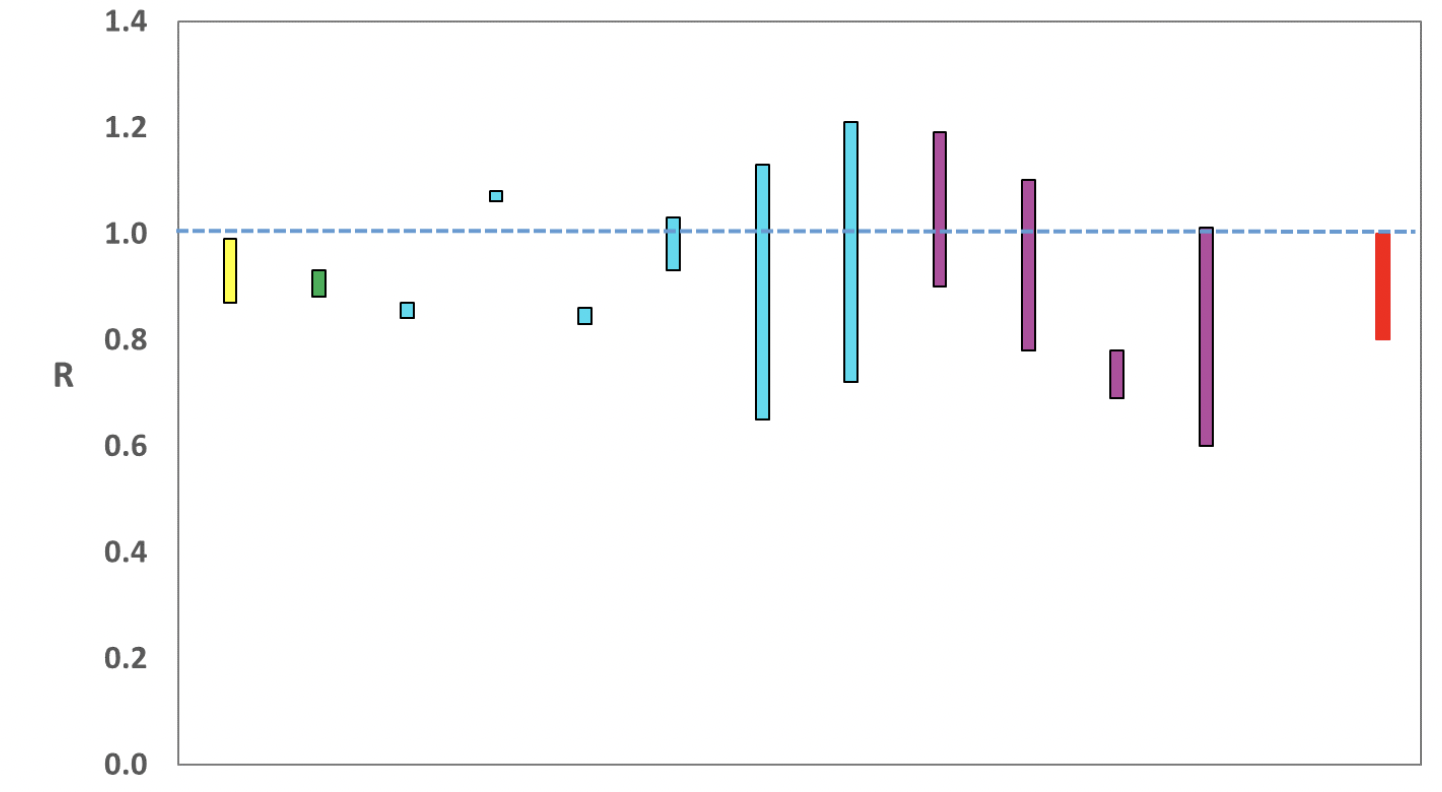
Source: EMRG
The various groups which report to the EMRG use different sources of data in their models to produce estimates of incidence (Figure 3). UKHSA's consensus view across these methods, as at 28th September, was that the incidence of new daily infections in Scotland was between 94 and 142 new infections per 100,000. This equates to between 5,100 and 7,800 people becoming infected each day in Scotland. The lower and upper limits have decreased since last week.
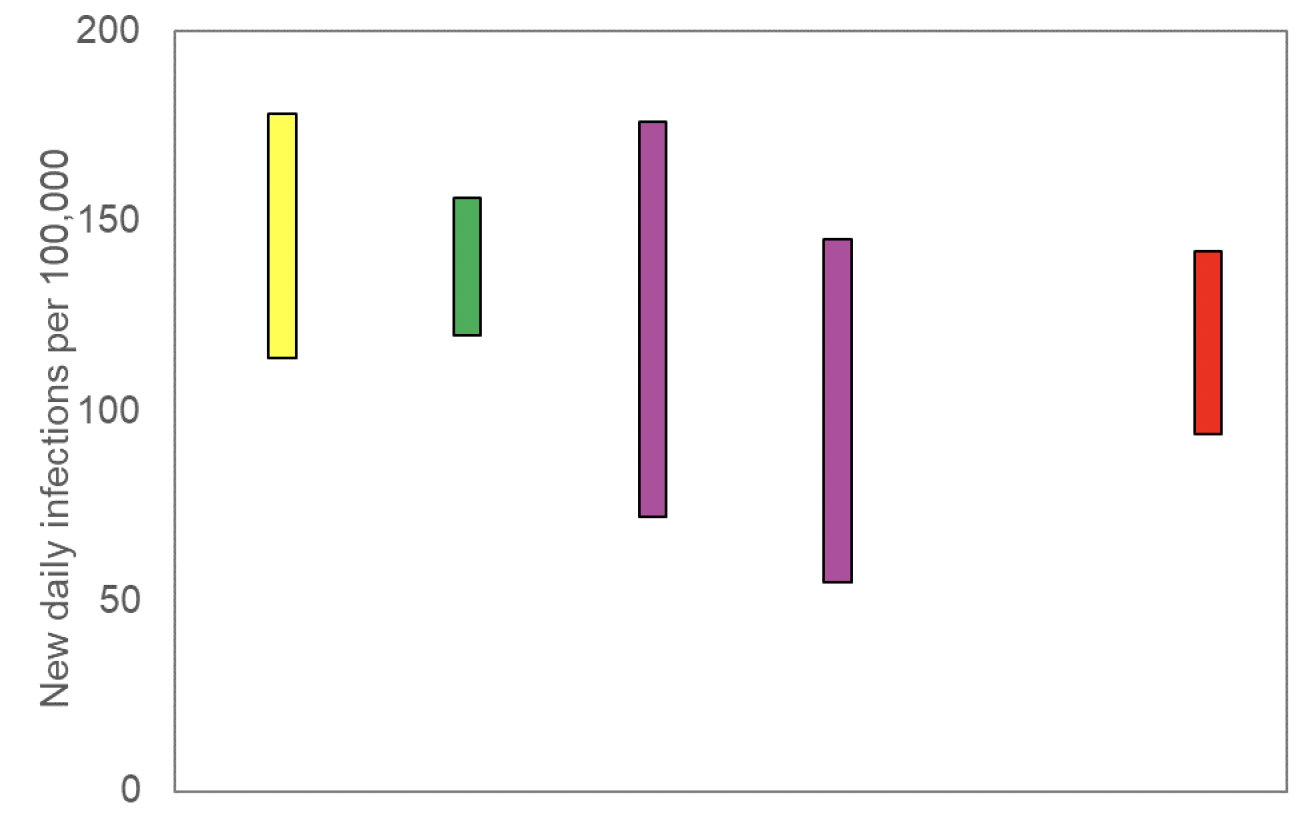
Source: EMRG
The consensus from UKHSA for this week is that the growth rate in Scotland is between -3% and 0% per day as at 28th September. The lower and upper limits have increased since last week.
What we know about how people's contact patterns have changed
Average contacts have decreased by 7% in the last two weeks (comparing surveys pertaining to 16th September - 22nd September and 30th September - 6th October) with a current level of 4.6 daily contacts as seen in Figure 4. Mean contacts within the home have increased by 9% whereas contacts in the other setting (contacts outside home, school and work) have decreased by 22% in the last two weeks. Contacts within the work have remained at a similar level over the same period.
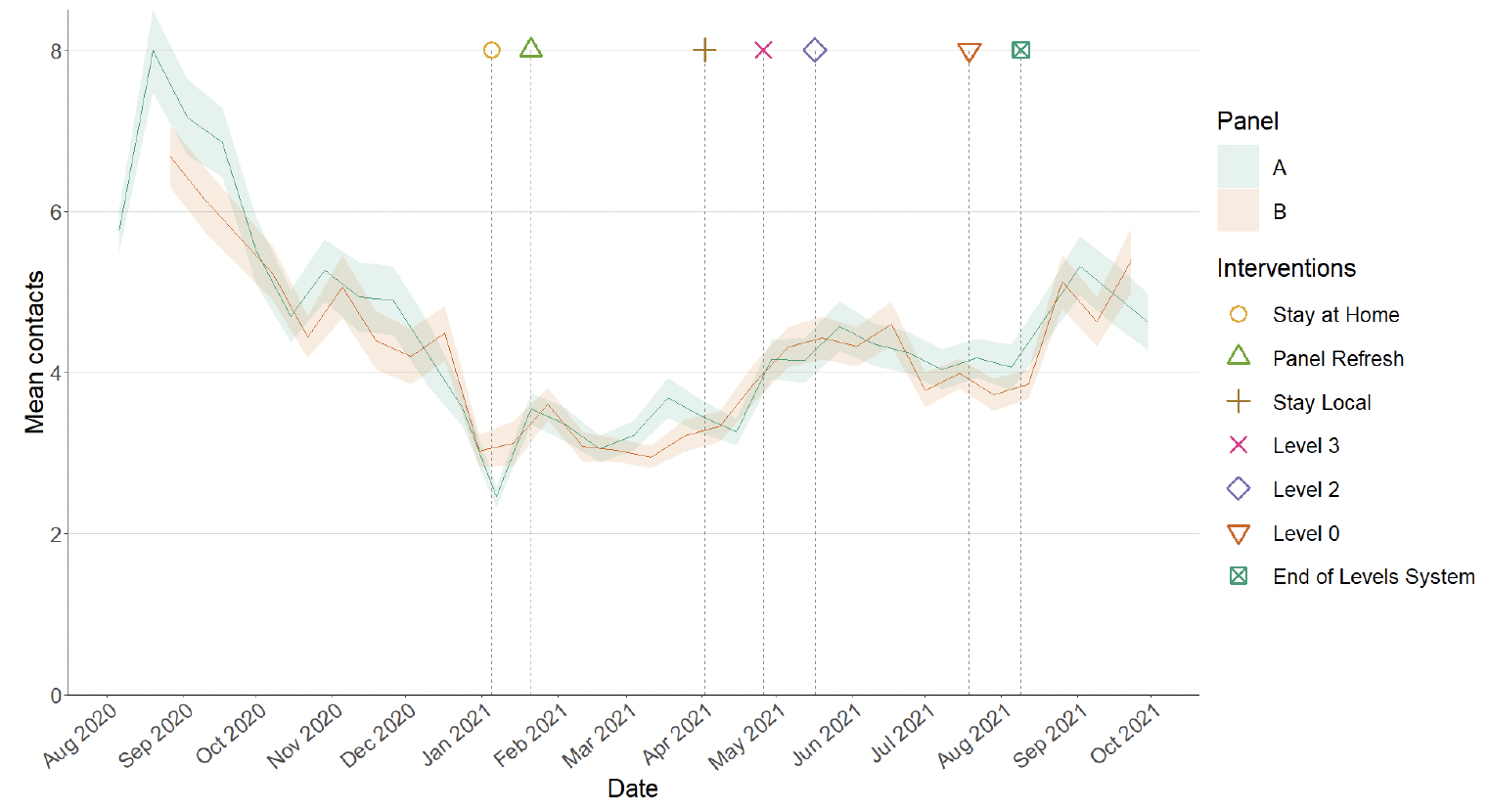
Contacts tend to be lower during half terms and holidays, with term times varying across Scotland. During the October half term in 2020, overall contacts reduced by approximately 15%, with contacts within the work setting decreasing by around 32%. This was followed by an uptick in contacts after the end of half term.
Figure 5 shows how contacts change across age group and setting. Those aged between 30-59 reported an increase in overall contacts whereas all remaining age groups reported a decrease, with those aged 18-29 reducing by half in the last two weeks. The decrease within the 18‑29 year group is largely driven by a drop in contacts within the work setting.
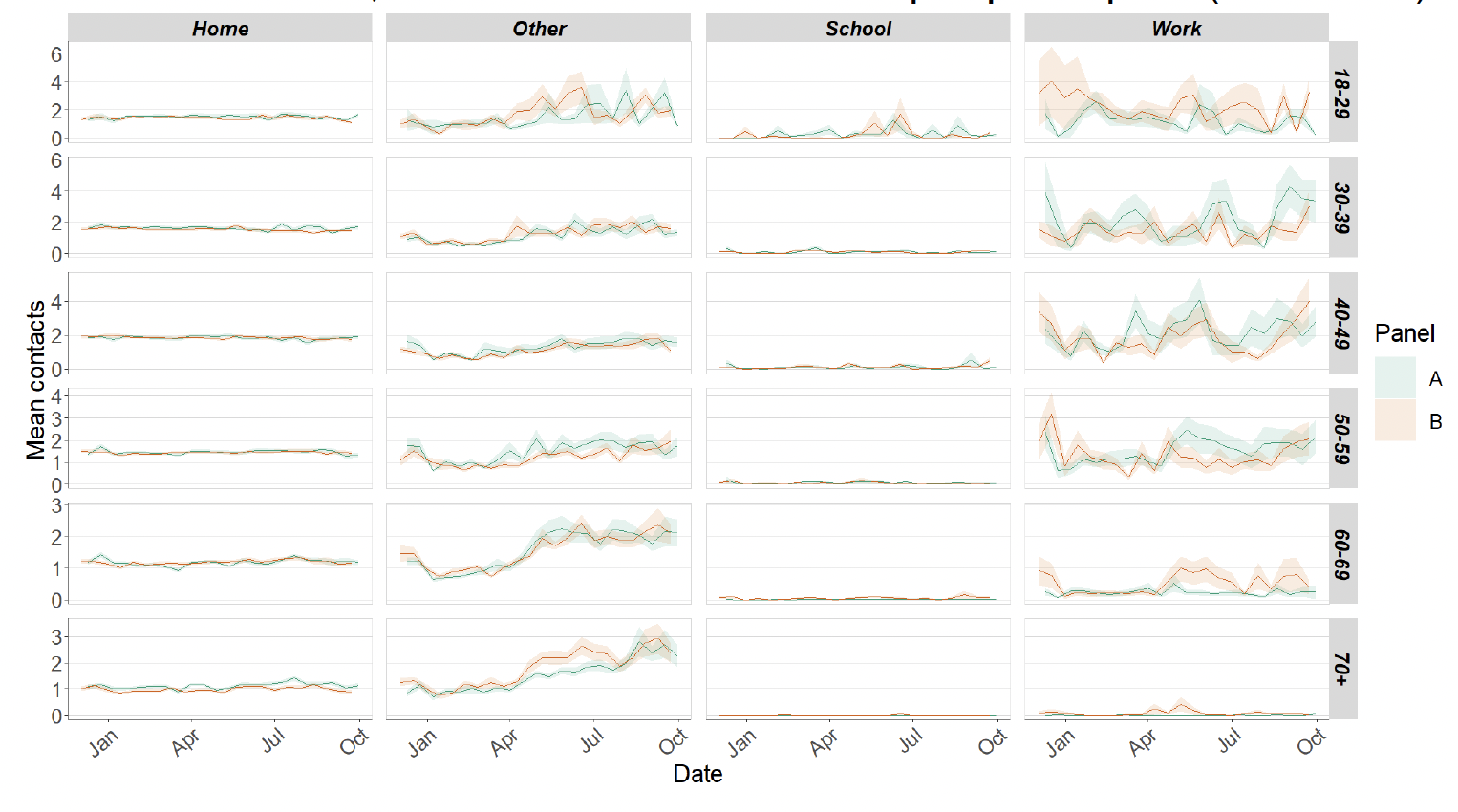
The heatmaps in Figure 6 show the mean overall contacts between age groups for the weeks relating to 16th September - 22nd September and 30th September - 6th October and the difference between these periods. Those aged between 30-39 have reported the biggest increase in interactions with those aged under 18 in the last two weeks. Interactions between the 18-29 age group with each other has shown the biggest decrease.
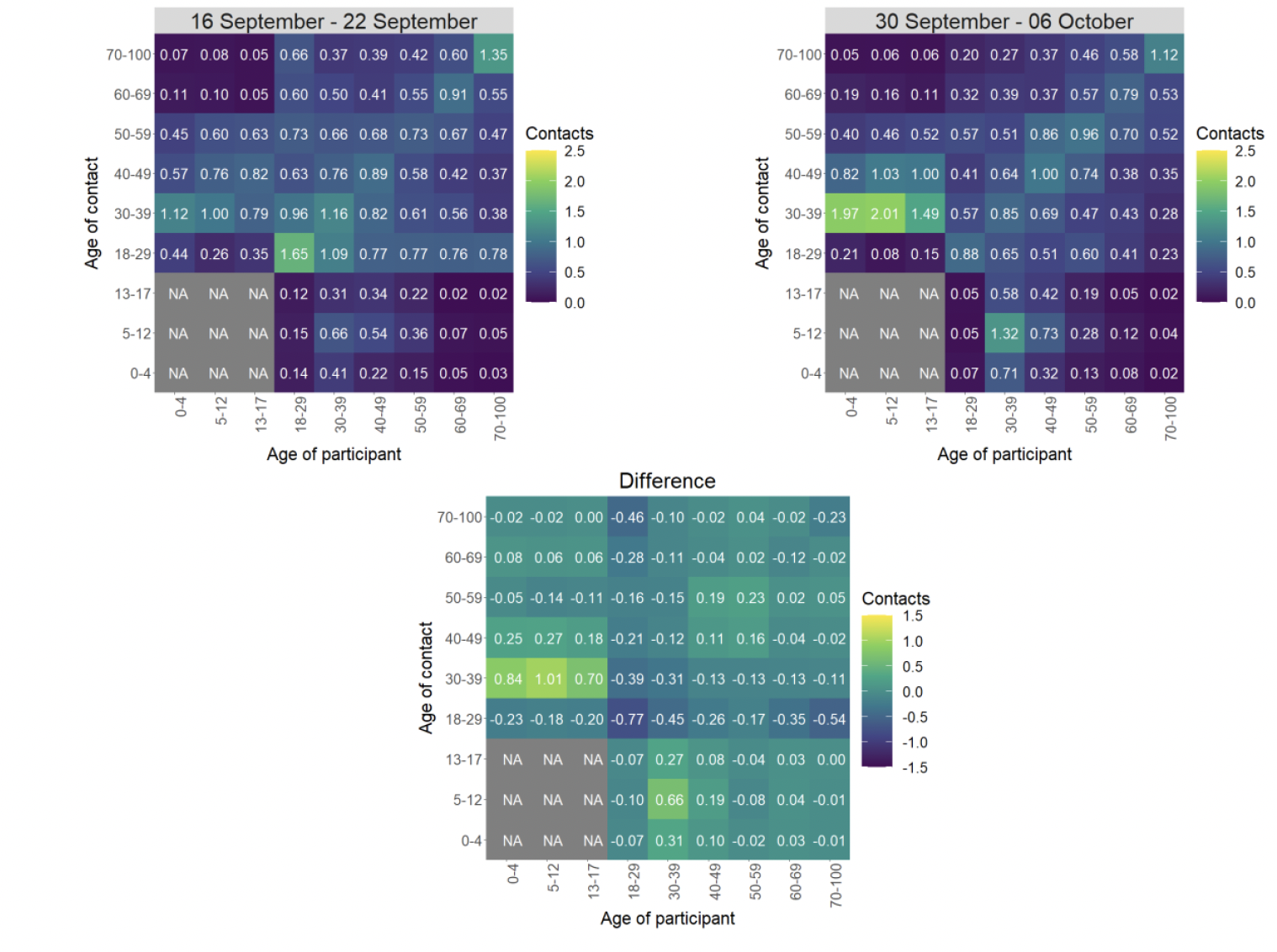
As seen in Figure 7, the proportion of participants visiting different locations remains at similar levels across the majority of locations. The biggest differences are seenwith those visiting a healthcare facility and also individuals visiting a pub or restaurant. The proportion of individuals visiting a healthcare facility increased from approximately 17% to 23% with individuals visiting a pub or restaurant decreasing from 49% to 47% in the last two weeks.
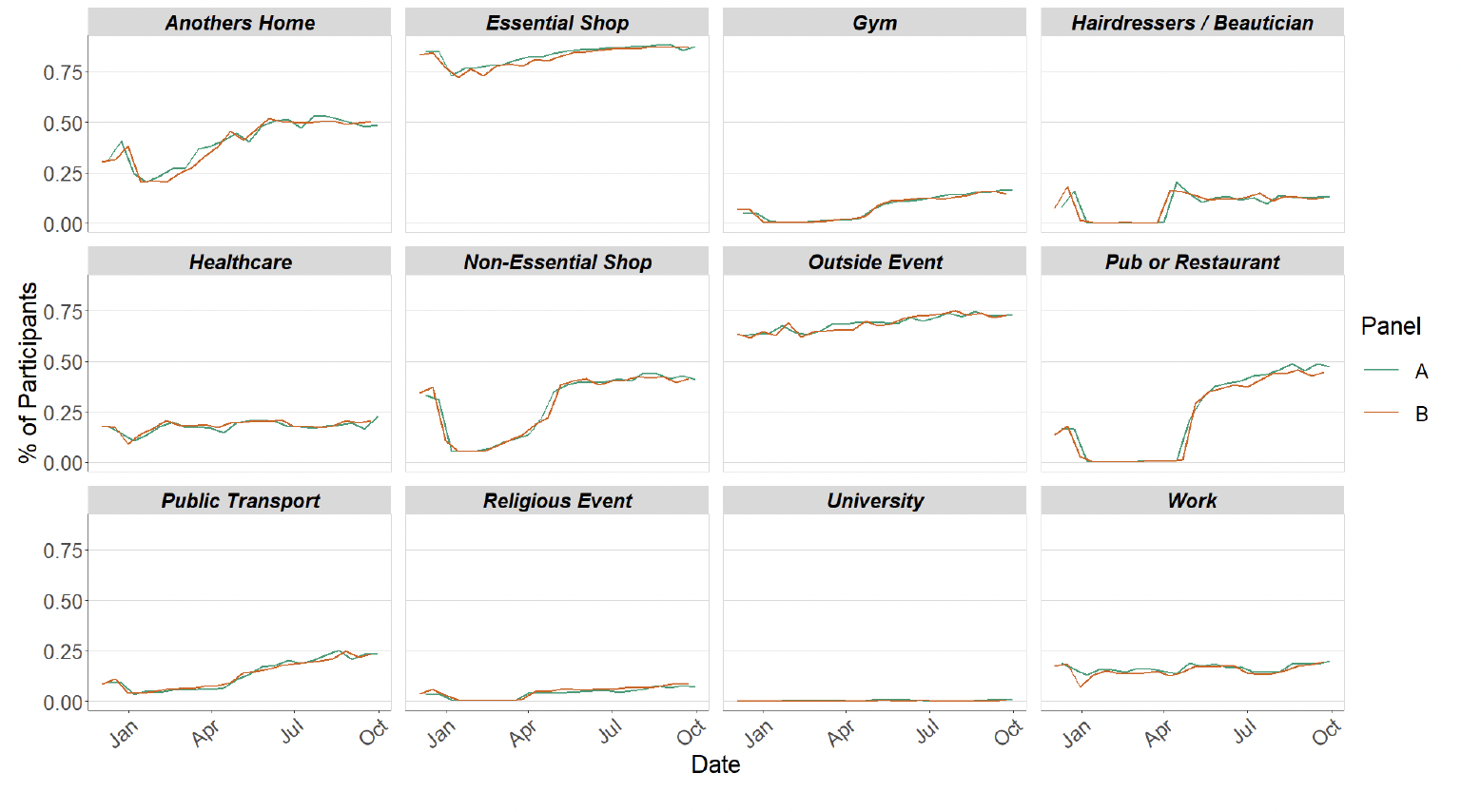
Figure 8 shows the proportion of participants that reported contacts had indoors and outdoors for contacts individually reported for panel A. A contact can also be recorded as both indoor and outdoor. The proportion of contacts reported to have been indoors only has increased from 61% to 68% within the last two weeks.
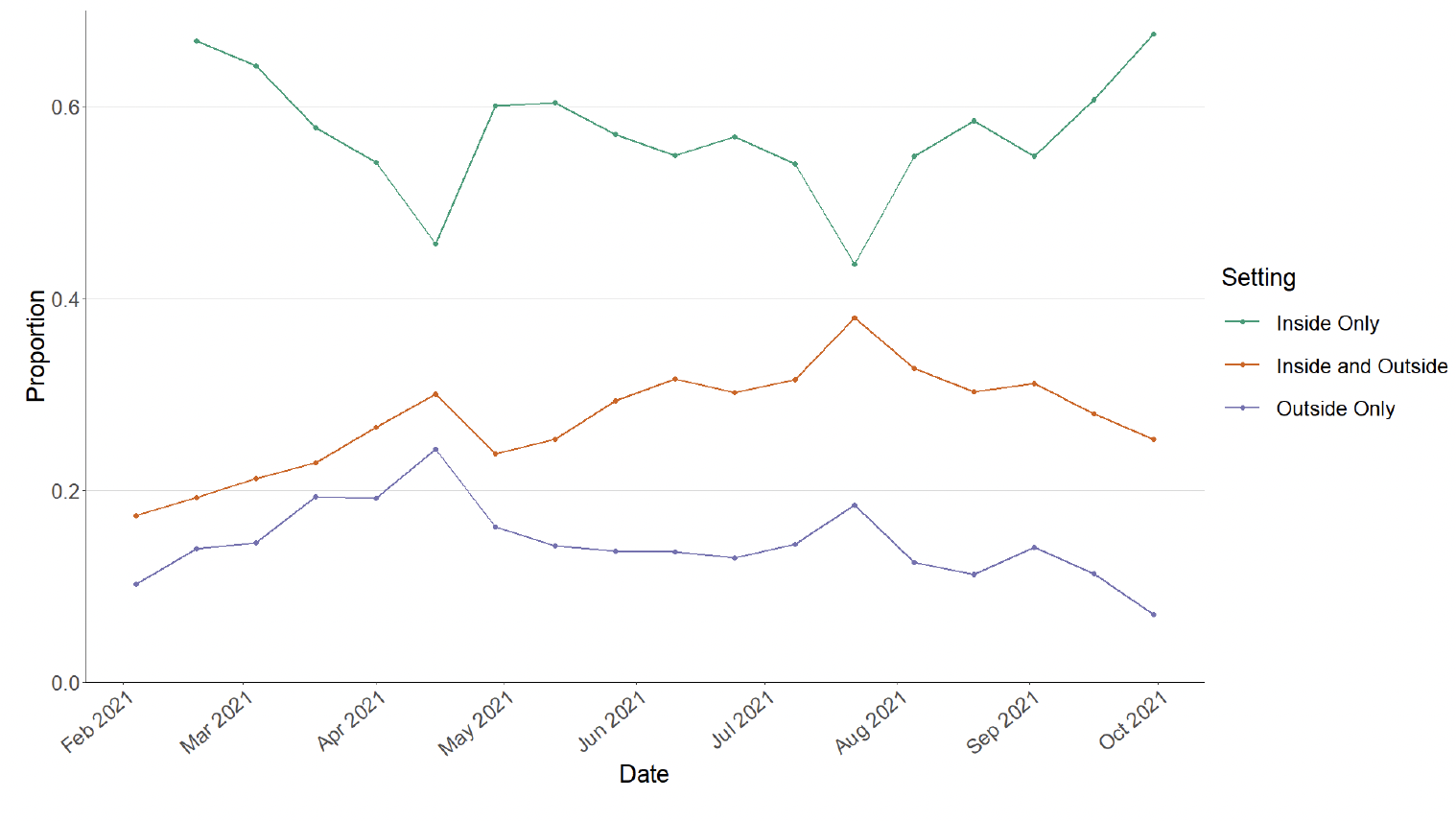
Figure 9 shows the number of people wearing a face covering where they have at least one contact outside of the home. This remains at a similar level to two weeks prior, currently at 81%.
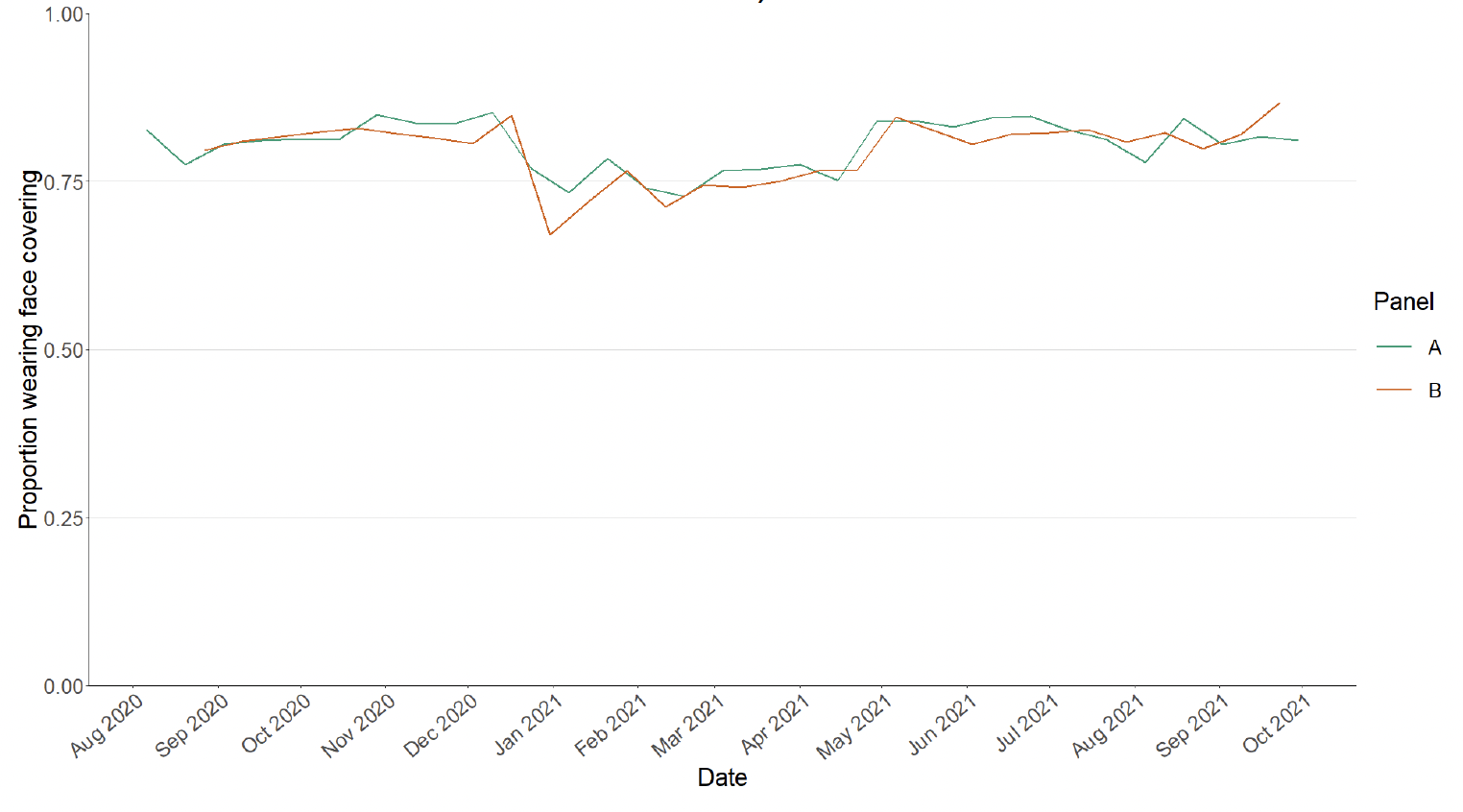
What the modelling tells us about estimated infections as well as Hospital and ICU bed demand
The Scottish Government assesses the impact of Covid-19 on the NHS in the next few weeks in terms of estimated number of infections. Figure 10 shows three projections over the three weeks to 31st October.
'Worse' assumes a rise in transmission similar to that seen in June and August. 'Central' assumes that infections will plateau at the current level. 'Better' assumes that infections will fall[5].
As noted earlier, contacts tend to be lower during half term and holidays. The modelling accounts for a reduction in transmission from schools being closed. At present, we are seeing relatively constant case numbers, which could begin to rise again when schools return. This can be seen towards the end of the three weeks modelled.
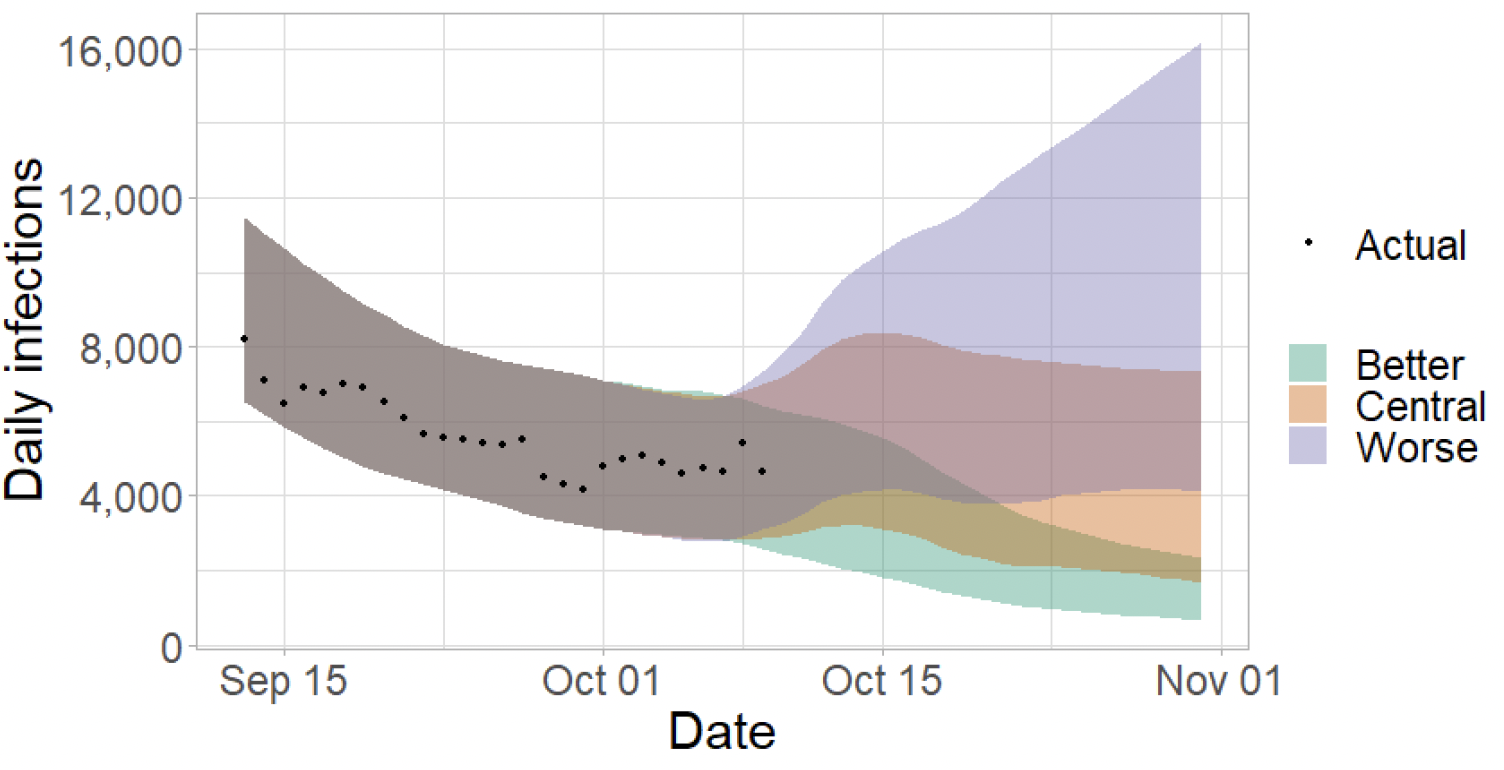
Figure 11 shows the impact of the projections on the number of people in hospital. The modelling includes all hospital stays, whereas the actuals only include stays up to 28 days duration that are linked to Covid-19.
There continues to be uncertainty over hospital occupancy and intensive care in the next three weeks.
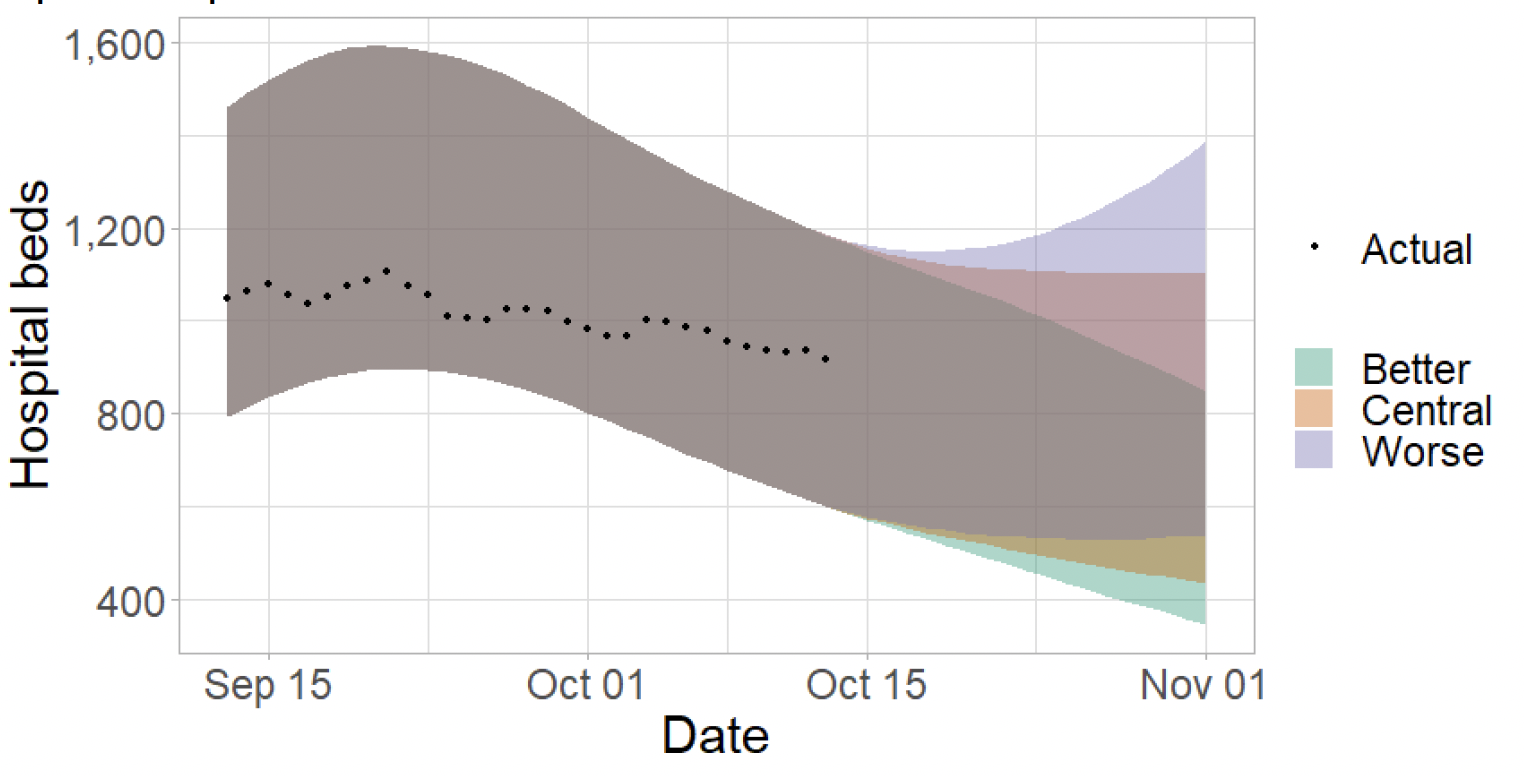
Figure 12 shows the impact of the projection on ICU bed demand.
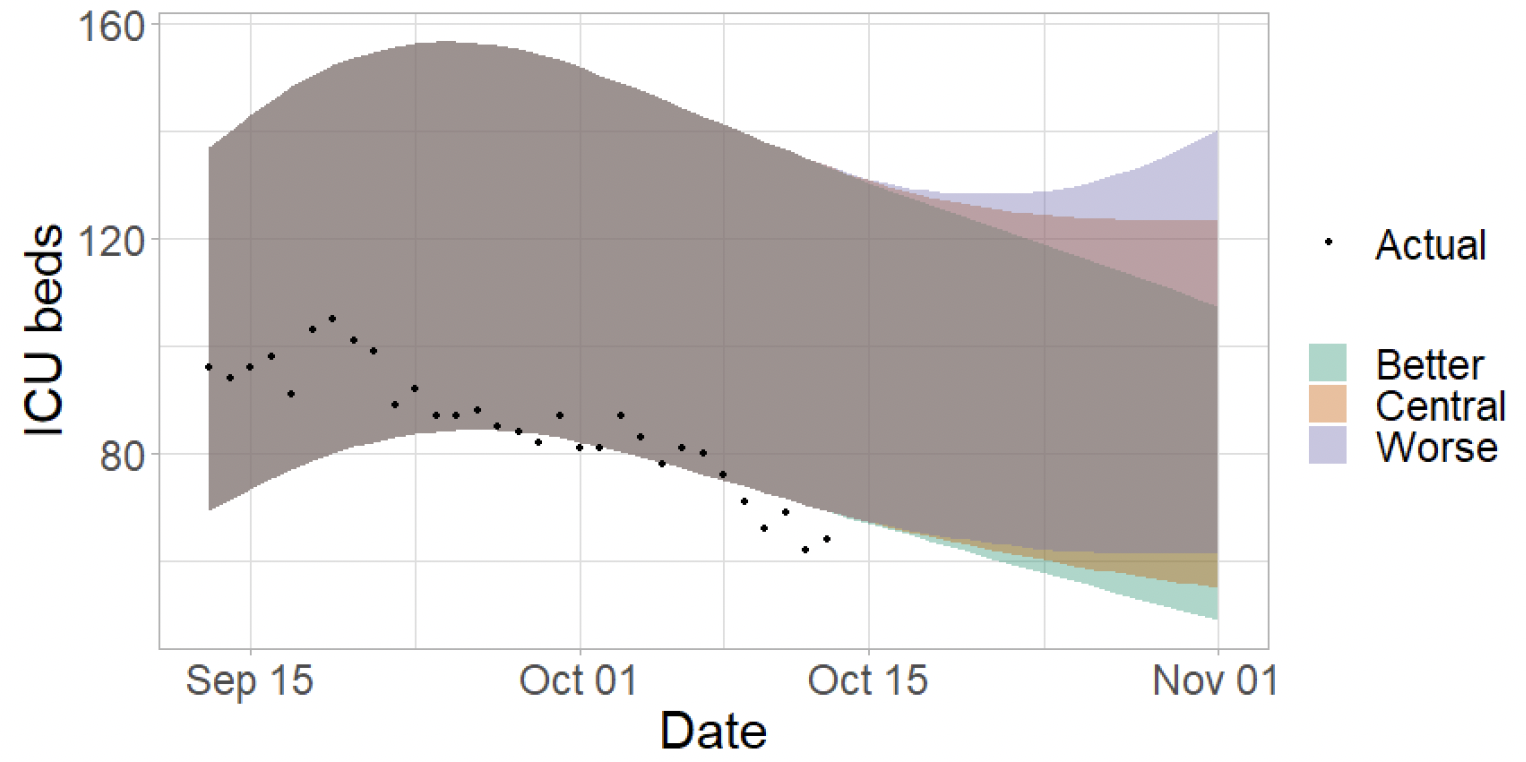
A comparison of the actual data against historical projections is included in the Technical Annex.
What the modelling tells us about projections of hospitalisations and deaths in the medium term
SPI-M produces projections of the epidemic[8] (Figures 13 and 14), combining estimates from several independent models (including the Scottish Government's logistics modelling, as shown in Figures 10-12). These projections are not forecasts or predictions. They represent a scenario in which the trajectory of the epidemic continues to follow the trends that were seen in the data up to 11th October and do not include the effects of any future policy or behavioural changes.
The delay between infection, developing symptoms, the need for hospital care, and death means they cannot fully reflect the impact of behaviour changes in the two to three weeks prior to 11th October. Projecting forwards is difficult when the numbers of admissions and deaths fall to very low levels, which can result in wider credible intervals reflecting greater uncertainty. The interquartile range should be used, with judgement, as the projection from which estimates may be derived until the 2nd November.
These projections include the potential impact of vaccinations over the next few weeks. Modelling groups have used their expert judgement and evidence from UKHSA, Scottish Universities & Public Health Scotland, and other published efficacy studies when making assumptions about vaccine effectiveness.
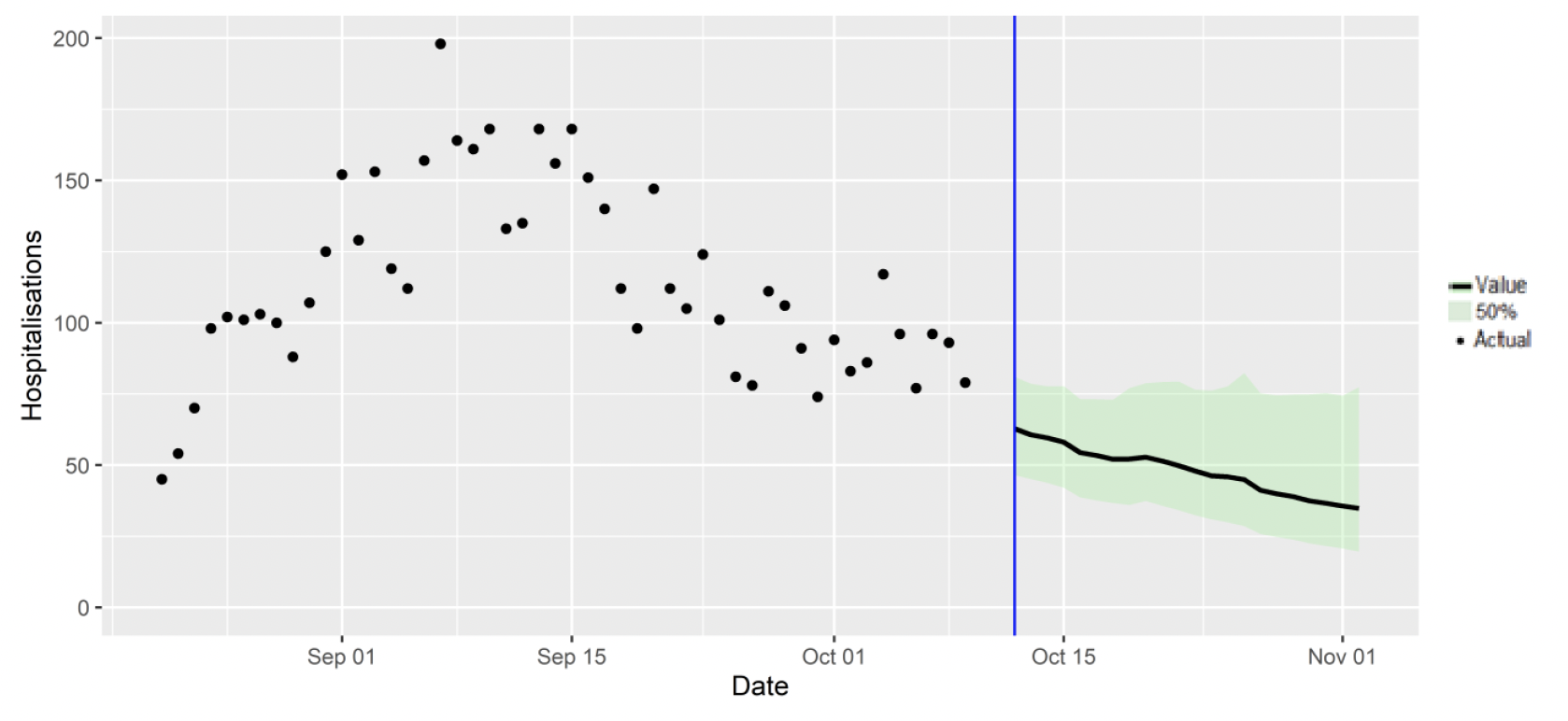
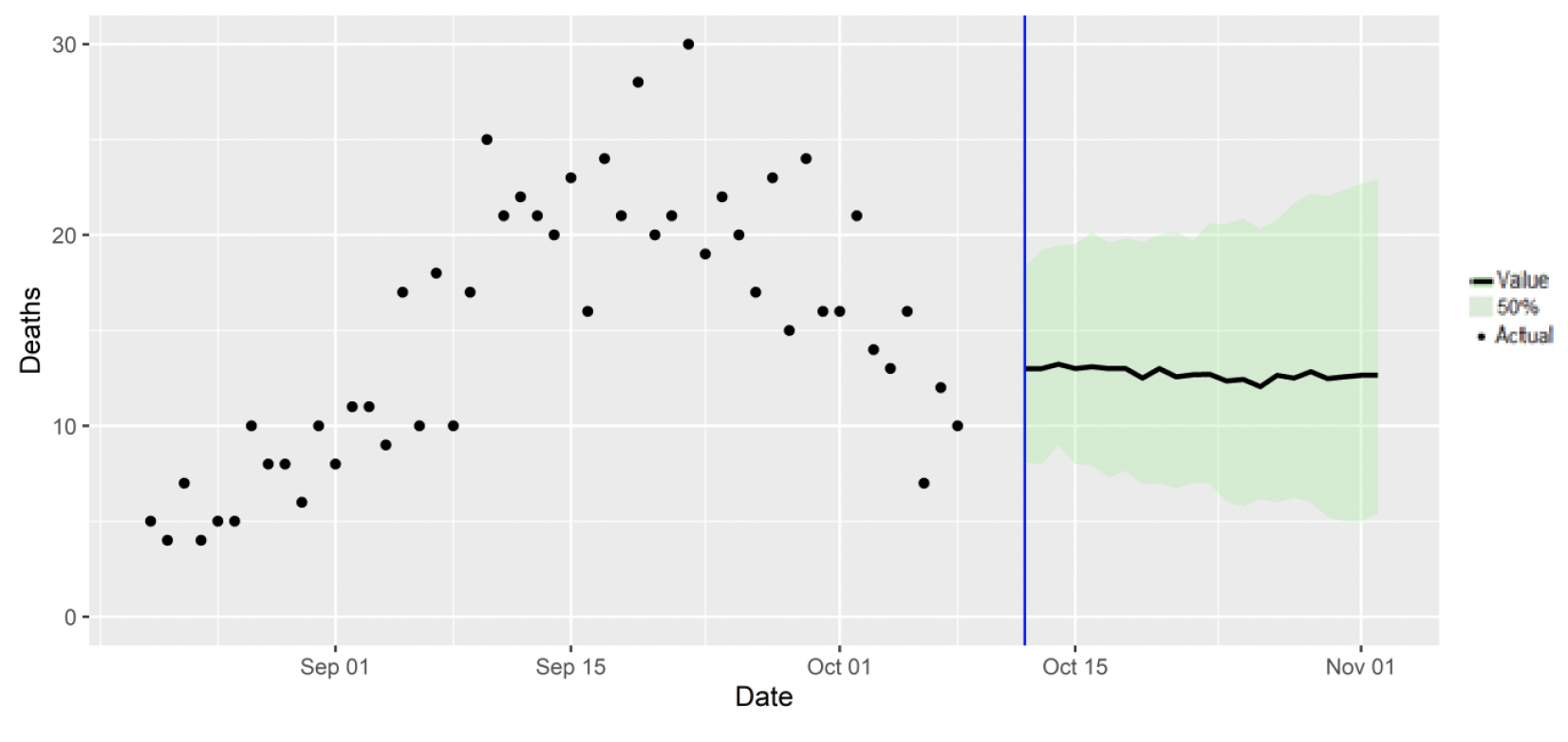
What we know about which local authorities are likely to experience high levels of Covid-19 in two weeks' time
We continue to use modelling based on Covid-19 cases and deaths using data to 11th October from several academic groups to give us an indication of whether a local authority is likely to experience high levels of Covid-19 in the future. This has been compiled via UKHSA into a consensus. In this an area is defined as a hotspot if the two week prediction of cases (positive tests) per 100K population is predicted to exceed a threshold, e.g. 500 cases.
Modelled rates of positive tests per 100K using data to 11th October (Figure 15) indicate that, for the week commencing 24th October 2021, there are 29 local authorities which are expected to exceed 50 cases per 100k with at least 75% probability[10].
There is one local authority (Dundee) which is expected to exceed 300 cases per 100k with at least 75% probability.
There are no local authorities which are expected to exceed 500 cases per 100k with at least 75% probability[11].
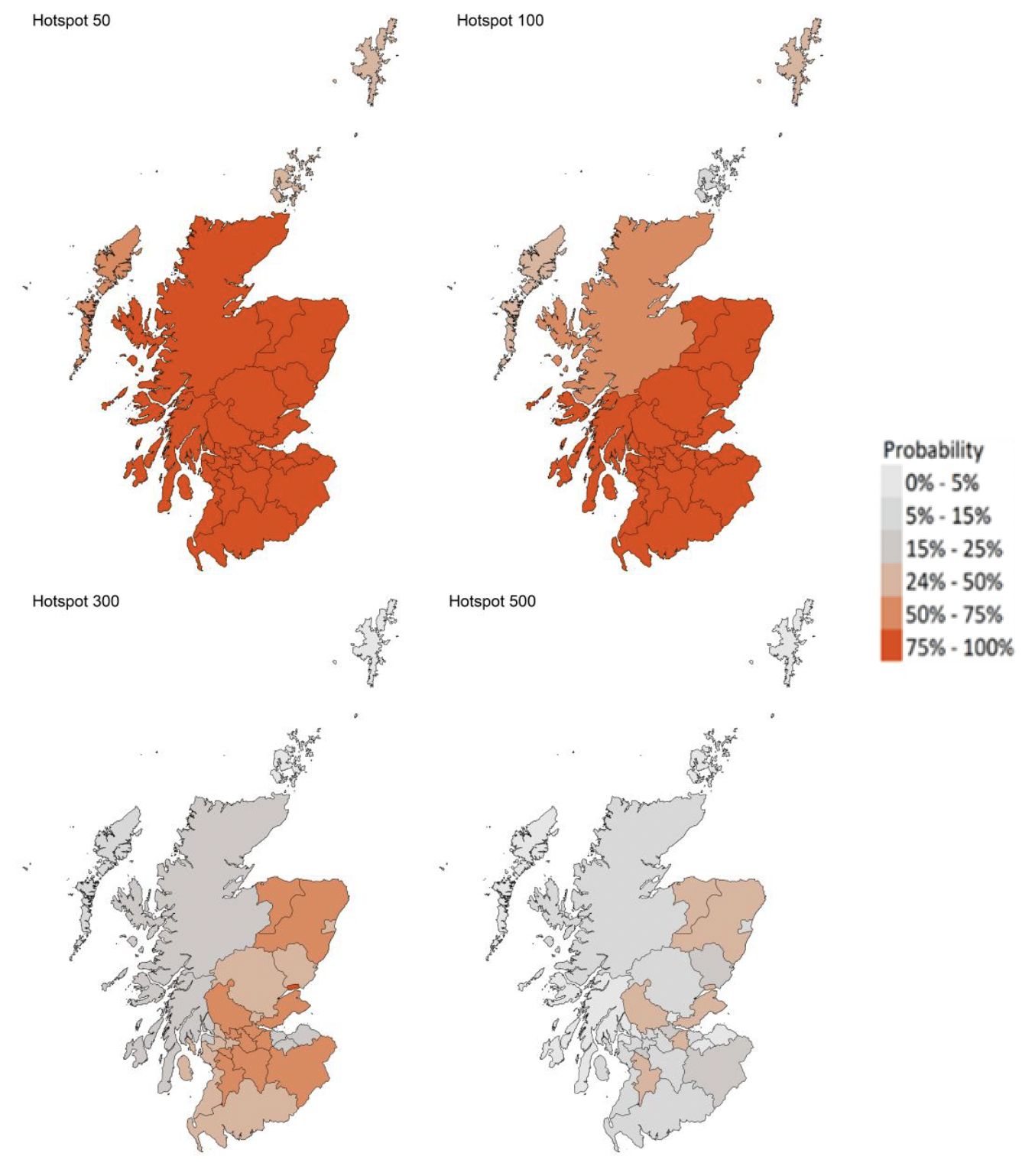
What can analysis of wastewater samples tell us about local outbreaks of Covid-19 infection?
Levels of Covid-19 RNA in wastewater (WW) collected at a number of sites around Scotland are adjusted for population and local changes in intake flow rate and compared to 7 day average daily new case rates derived from Local Authority and Neighbourhood (Intermediate Zone) level aggregate data. See Technical Annex in Issue 34 of these Research Findings for the methodology.
Nationwide, after seeming to plateau recently, levels of WW Covid-19 resumed falling this week, reaching around 56 million gene copies per person per day (Mgc/p/d) in the week ending 12th October, down around 40% from the week ending 5th October. Reductions in sampled levels at the major cities drove this decrease, though there remain high amounts of variability.
Figure 16 shows the national running average trend for the full set of sampled sites, with a small number of unrealistically large outliers excluded. The number of wastewater samples analysed continues to be at a reduced level, standing at around 100 samples per week. This means caution is required in interpreting levels at some of the smaller sites or less densely populated local authorities.
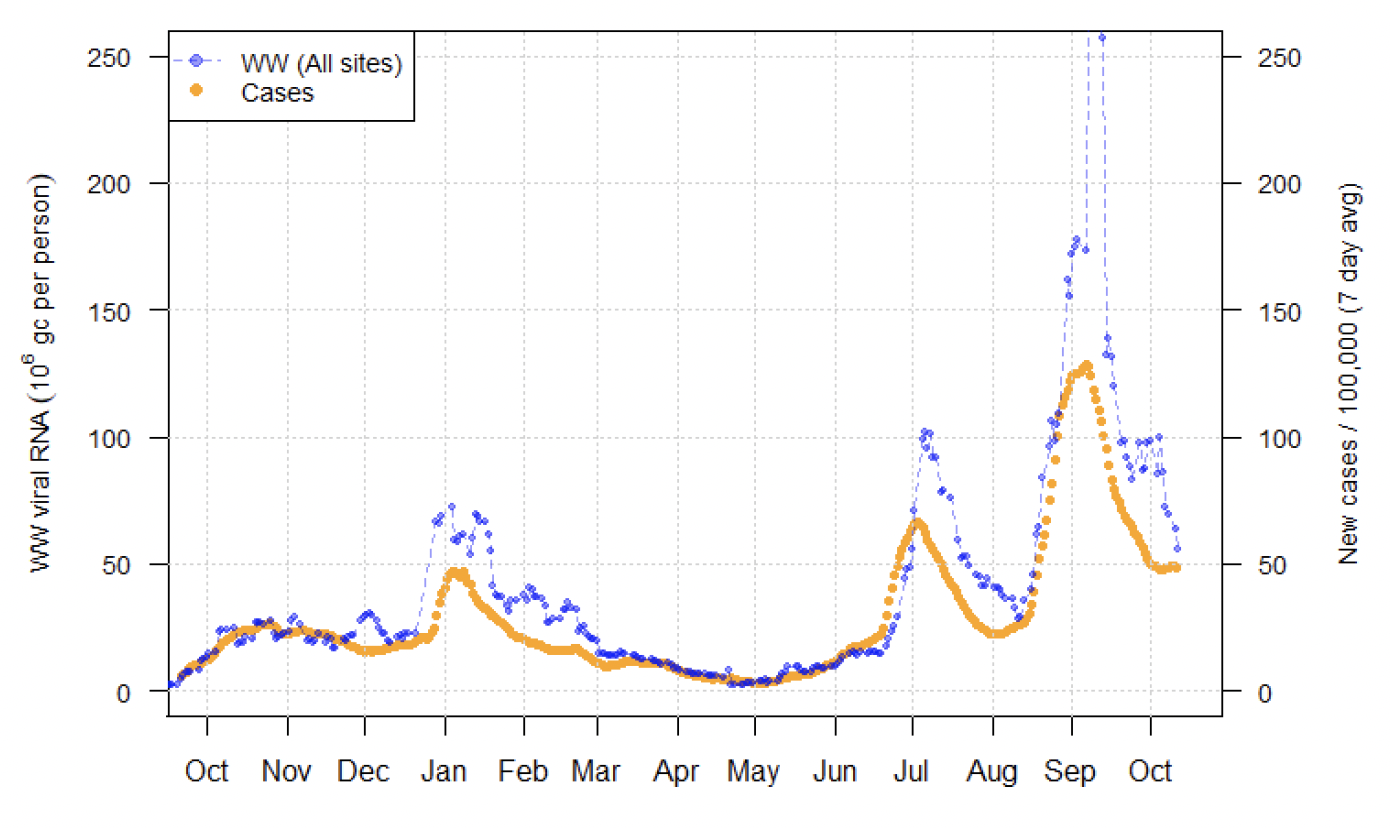
What estimates do we have of the number of people experiencing long Covid symptoms?
The Scottish Government is modelling the number of people likely to experience long Covid symptoms. This gives a projection of estimated self-reported long Covid rates in the future, based on Scottish Government medium term projection modelling, as set out in Figure 17.
This modelling estimates that at 31st October 2021 between 58,000 (1.1% of the population) and 129,000 (2.4%) people are projected to self-classify with long Covid for 12 weeks or more after their first suspected Covid infection in Scotland.
These are preliminary results, further data on rates of long Covid and associated syndromes as research emerges are required.
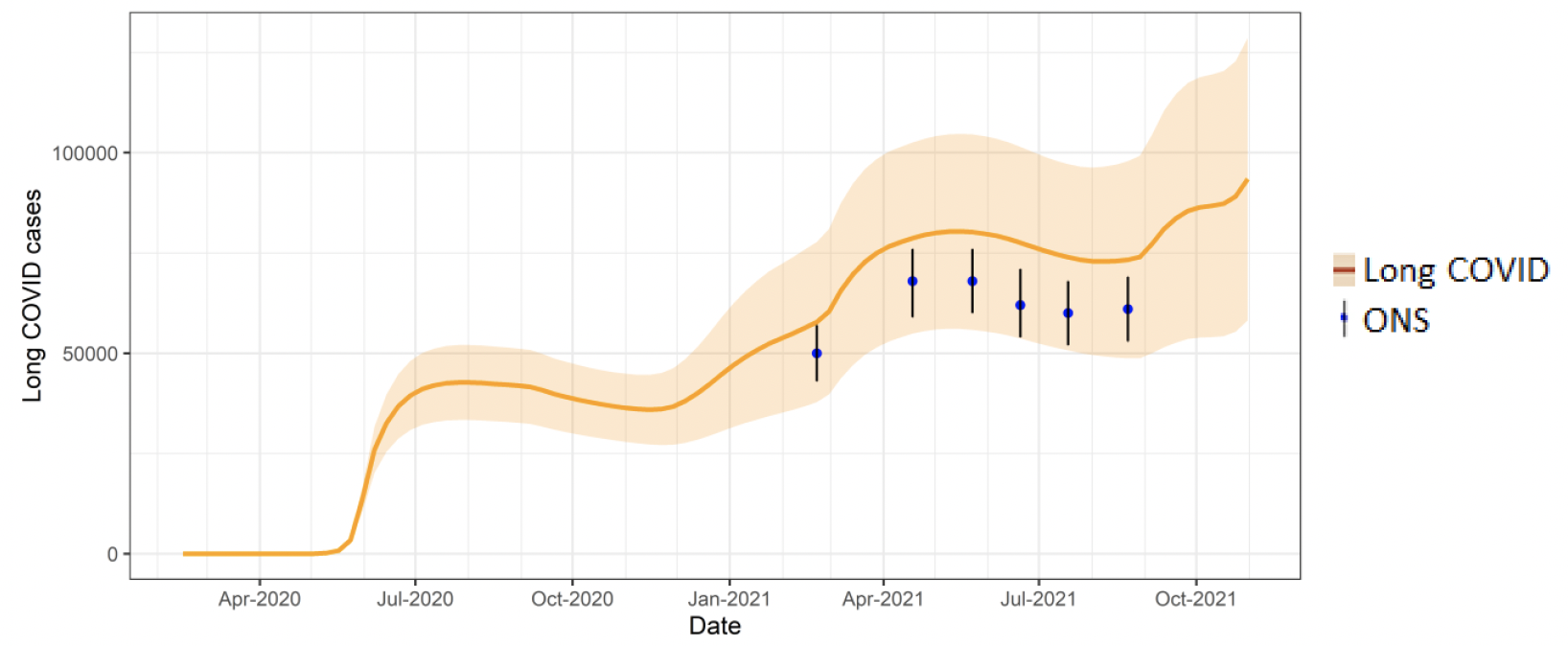
See the Technical Annex for information about the methodology.
What next?
The modelled estimates of the numbers of new cases and infectious people will continue to be provided as measures of the epidemic as a whole, along with measures of the current point in the epidemic such as Rt and the growth rate. Further information can be found at https://www.gov.scot/coronavirus-covid-19.
We may report on exceedance in future weeks when the background levels of Covid-19 reduces so that it can be useful in identifying outbreaks.
Contact
There is a problem
Thanks for your feedback